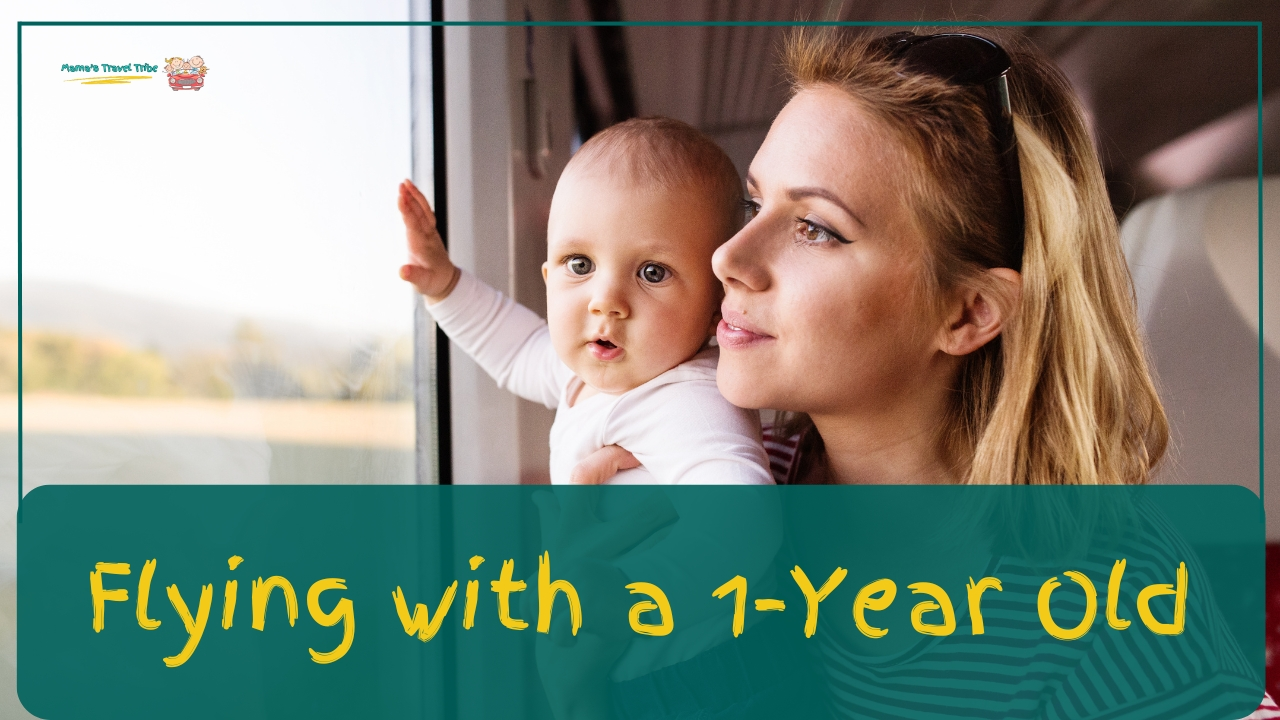Looking for tips for flying with a 1 year old? You’re in the right place! I’ll share simple strategies to keep your journey smooth and enjoyable. I’m covering everything here – from takeoff to landing.
Stick around for expert insights that make flying with a little one a breeze!
Tips for Flying With a 1 Year Old: 21 Things You Should Do
When flying with a 1 year old, book direct flights and align them with nap times to enhance comfort. Also, use a car seat approved for flights, and dress your child in comfortable layers. Furthermore, offer a pacifier or bottle during takeoff and landing.
Let’s now read all 21 baby tips.
Book Direct Flights
I always recommend booking direct flights whenever you can. Why? Because it cuts down on travel time tremendously. Imagine juggling a fussy toddler, a diaper bag, and your own luggage through multiple airports—it can get overwhelmingly fast!
Direct flights mean you get from point A to point B without the extra hassle of changing planes or sprinting through terminals during a tight layover. It’s simpler, and simplicity is key when you’re flying with a one-year-old or even a newborn baby.
Choose Convenient Flight Times
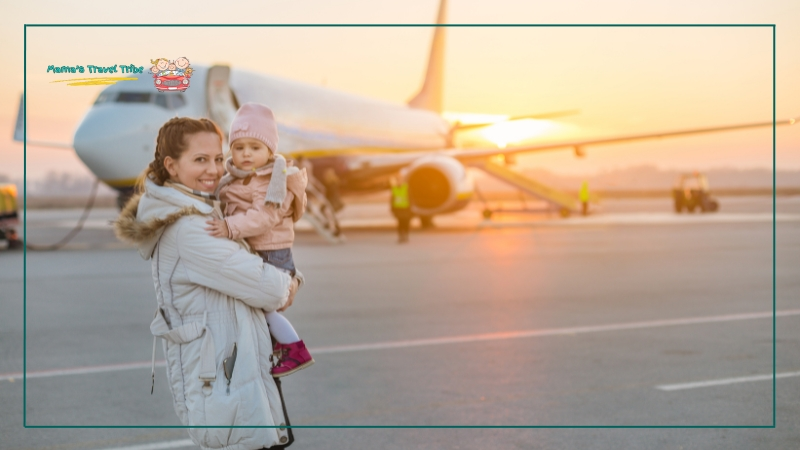
Now, let’s talk about timing. If you read the guide on tips for international travel with a baby, you will notice that the baby’s sleep schedule is often discussed.
And if there’s one thing I’ve learned, it’s that aligning your flight schedule with your child’s sleeping pattern can be a game-changer. Aim to schedule your flight during your baby’s usual naptime or bedtime. This way, there’s a good chance they’ll snooze through most of the journey.
Flying during their usual sleep hours means less stress for both of you and who doesn’t want a quieter, more peaceful flight?
Pack Wisely
When you’re packing for a flight with your one-year-old, think of your carry-on bag as a survival kit. Over the years, I’ve found that being prepared makes all the difference during family traveling.
Start with the basics: diapers and wipes are a must. How many diapers? I generally recommend making a packing list and then taking one diaper for each hour you’ll be traveling. You should also take a few extras just in case of delays.
Don’t forget to bring enough formula, breast milk, or toddler snacks. Air travel can be unpredictable, and having food handy can prevent a lot of discomfort. Remember, liquids have special rules at airport security, but baby food is usually allowed in reasonable quantities. Just make sure to declare these items so they can be screened separately.
A change of clothes is essential, not just for your baby, but for you as well. Spills or accidents might happen, and staying comfortable is key. Also, include a blanket or any comfort item that helps your baby feel secure and cozy.
This could be a favorite small toy or a pacifier. These familiar items can be very soothing in a new environment, like an airplane.
Bring Entertainment
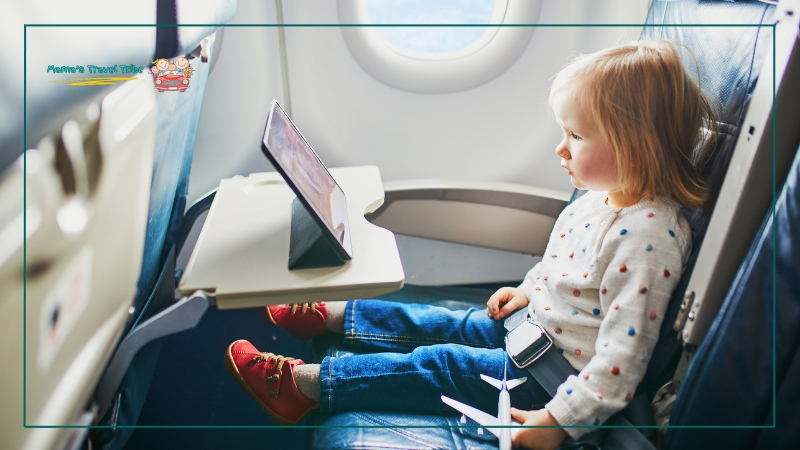
Keeping a one-year-old entertained on a flight is crucial. It’s also super important if you’re taking a baby on a plane for the first time.
Toys, books, and games that fit easily into your travel bag can be lifesavers. I like to mix it up with a combination of new toys and old favorites; the novelty items capture their attention, and the familiar ones provide comfort.
In this digital age, a tablet can be your best friend. Download a few kid-friendly apps, shows, or movies. Make sure these are available offline so you don’t need to rely on airplane Wi-Fi. Interactive story apps or simple puzzle games are great for keeping little hands busy. And don’t worry about screen time—travel days are exceptional days!
Comfortable Clothing
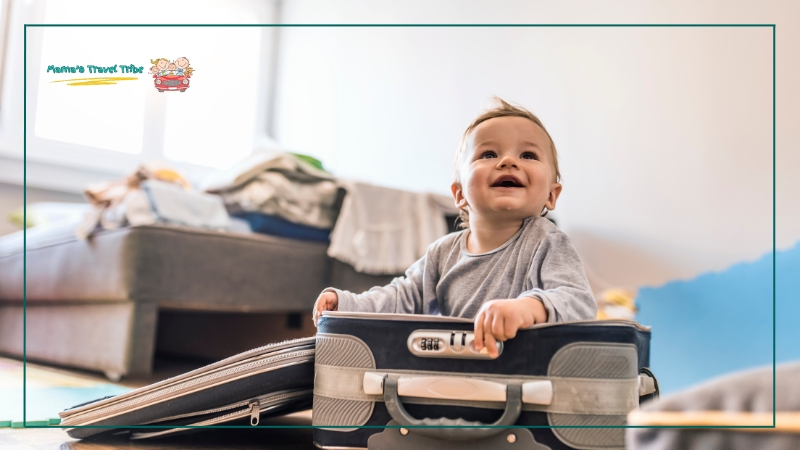
Dressing your child for a flight is one of the best tips for traveling with an infant by plane. I always suggest going with layers. Why layers? Because the temperature on planes can vary—a little chilly one minute and a bit warm the next.
Start with a base layer. Here, I pick a soft cotton onesie. Then, add a long-sleeve top and pants, and finally, a sweater or a hoodie that can be easily removed. Soft, stretchy fabrics are your best bet for ensuring your child stays comfy throughout the flight.
Don’t forget to pack a cozy blanket. A familiar, soft blanket can help your little one feel snug and secure, making it easier for them to nap amidst the hustle and bustle of the cabin. This blanket isn’t just for warmth; it’s a piece of home to help soothe your baby in an unfamiliar place.
Child-Friendly Seating: One of the Most Important Baby Traveling Tips
Choosing the right seat can significantly enhance your travel experience, especially when flying with a young child. If it’s an option, I recommend booking an extra seat next to you. Having this extra seat not only gives you more room to manage your child’s needs but also provides a space for them to play or lay down with their blanket and toys.
Bulkhead seats are a fantastic choice when available. These seats usually offer extra legroom and space, which is extremely valuable when you need to change a diaper or just stretch a bit without bumping into the passenger in front of you.
Again, securing an extra seat in this row can make a world of difference, giving you that much-needed extra space to ensure both you and your child have a comfortable flight.
Gate Check Stroller and Car Seat
When you’re flying with a little one, bringing along a stroller and a car seat can make a big difference. Most airlines understand this and offer to gate-check these items for free. What does gate-check mean?
This means you can use your stroller and car seat up to the plane’s gate. Then, you can hand them over to the airline staff just before you board. Once you land, they’ll be returned to you right at the gate.
Why is this so helpful? First, having a travel stroller in the airport lets your child rest or nap comfortably as you navigate through the terminals. It’s also handy for carrying diaper bags and any duty-free shopping you might pick up.
As for the car seat, it’s not just about in-flight use. When you reach your destination, having your seat ensures you’re ready to travel safely by car without needing to rent or buy a new one.
I always advise parents to use the seat for both safety and familiarity—it helps keep the child secure and comfortable during car rides.
Board Early
Many airlines offer families the chance to board early. If you have this option, take it! Boarding early is a chance to settle in without the stress of navigating through a crowd of passengers. It gives you a moment to stow your carry-on items, install the seat if you’re bringing it onboard, and get your child comfortable with their surroundings before the plane fills up.
Here’s a tip from my years of experience: use this quiet time to walk your child around the cabin. Letting them get a good look at the airplane can turn it into an exciting part of the adventure. This can help ease any nervousness they might feel.
After the walk, getting them settled with a favorite toy or snack can make takeoff much smoother.
Be Prepared for Ear Pressure
When flying, changes in air pressure during takeoff and landing can bother your little one’s ears. This might make them feel uncomfortable or even cause them to cry. I’ve seen many parents worry about this, but there are simple ways to help your baby.
Try giving them something to suck on during these times—a pacifier, bottle, or breastfeeding can all do the trick. Sucking helps relieve the pressure and can distract them from any discomfort.
Remember, it’s completely normal for babies to have a tough time with this—it’s not a reflection on your parenting. Just being ready with a soothing solution can make a big difference.
Stay Calm
Traveling with a baby can get stressful, but it’s important to keep cool. Why? Because babies are very good at picking up on how we feel. If you’re anxious, your baby might become anxious, too. When I travel with little ones, I always focus on staying relaxed, no matter what comes up. This isn’t just good for you—it’s good for your baby too.
Keeping a calm demeanor helps create a peaceful environment for your child. Remember, this flight is just a small part of your adventure together. Stay patient and take things one step at a time.
Engage with Other Passengers
It’s a kind gesture to acknowledge those sitting around you when flying with a baby. A simple smile and a polite word before the flight starts can set a positive tone. If your baby does get fussy, your neighbors might be more understanding because of that initial interaction. I always say, “A little kindness goes a long way.”
You’d be surprised how many people are sympathetic and even offer to help when they see you’re making an effort to be considerate. This can make your flight more pleasant, not just for you but for everyone involved.
Safety First
When you’re up in the sky, safety is always the top priority. Make sure you always follow the airline’s safety regulations. This includes using seat belts correctly and, if you’re bringing one, securing your child in an approved car seat.
A car seat isn’t just for cars; it’s designed to protect your little one in case of turbulence or other in-flight issues. It must be airline-approved, though.
From my years of experience, I’ve seen that being diligent about these rules not only keeps everyone safe but also gives you peace of mind. You’ll be more relaxed knowing you’ve taken every precaution to protect your baby.
Ask for Help if Needed
Flying with a baby can be a handful, and it’s okay to need an extra hand. Don’t hesitate to ask for help from the flight attendants or even fellow passengers. Most people understand how challenging it can be and are usually more than willing to assist, whether it’s helping you with bags or just giving you a moment to use the restroom.
I always remind parents that asking for help isn’t a sign of weakness—it’s a smart way to manage your energy and keep your stress levels down. Remember, it’s about making the journey smoother for you and your baby.
Book a Bassinet
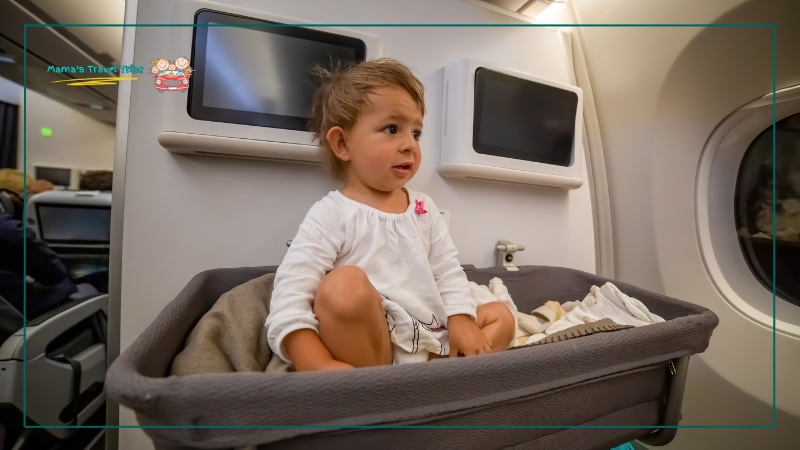
If you’re on a longer flight, look into booking a bassinet for your baby. Many airlines offer these for little ones who meet certain size and weight limits. A bassinet can be a game-changer, as it will help your baby in sleeping.
To ensure one is available, request this service as early as possible, as they are often limited. Having your baby secure in a bassinet also frees up your arms, allowing you some much-needed rest.
This can make all the difference in arriving feeling refreshed versus exhausted. This service is especially valuable on international or overnight flights where every bit of rest counts.
Pack Snacks and Drinks
When flying, keeping your little one hydrated and satisfied is crucial. I always pack a variety of snacks and drinks for the flight. Healthy options like cut-up fruits, crackers, and baby-friendly finger foods are not just nourishing but can also keep your child entertained through the journey.
These snacks are easy for small hands to manage and can be a great distraction during those moments of restlessness.
It’s important to consider the nutritional content and mess factor—soft fruits like bananas or steamed apple slices are excellent because they’re both healthy and easy to clean up. Remember, staying fed and hydrated can help mitigate ear discomfort caused by altitude changes, too.
Schedule Play Breaks
On longer flights, it’s a good idea to plan for little breaks where you can walk up and down the aisle with your child. If the airline has a designated play area for children, take advantage of it.
These breaks allow your child to stretch and move around, which is not only vital for their physical well-being but can also significantly reduce their restlessness.
It’s also a great way for both of you to engage with the environment in a controlled way, making the flight seem shorter and more enjoyable.
Be Mindful of Germs
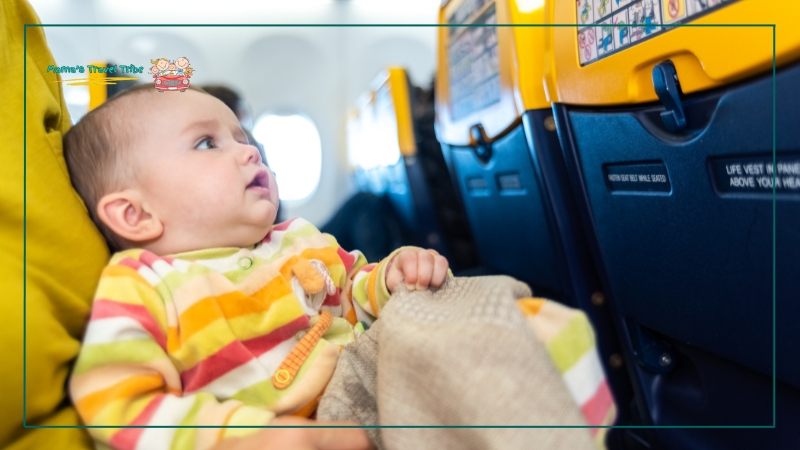
Airports and airplanes are high-traffic areas where germs can easily spread. To keep your child healthy, I always recommend bringing hand sanitizer and disinfectant wipes. Use these wipes to clean any surfaces your child might touch, like tray tables, armrests, and window seat shades.
A little precaution goes a long way in preventing sickness during and after your flight. Keeping hands and frequently touched areas clean can help avoid the transfer of germs to your child’s mouth and face, ensuring a healthier travel experience for everyone involved.
Stay Flexible
Traveling with a 1-year-old can often feel like you’re living on a tiny whirlwind schedule, and that’s perfectly normal. Things might not always go according to plan—flights get delayed, naps get missed, and sometimes, the pacifier falls right when you least expect it.
That’s why staying flexible is key. Adaptability becomes your best tool. Whether it’s switching flight times, changing a diaper at an inconvenient moment, or finding an unexpected spot for a play break, being prepared to pivot can help keep the stress levels down for both you and your baby.
Embrace the unpredictability as part of the adventure. Sometimes, those unplanned moments can lead to the sweetest memories with your little one. Remember, you’re learning and growing with every trip, just as much as your baby is.
Plan for Jet Lag
If you’re traveling across time zones, be prepared for jet lag and try to adjust your child’s sleep schedule gradually before the trip. Once you arrive at your destination, expose your child to natural light during the day.
Note that natural light is a powerful cue for the body, helping to reset internal clocks to the local time more quickly. Keep evening environments calm and dimly lit to encourage your child to wind down as nighttime approaches.
These small adjustments can help stabilize their rhythms, making the transition smoother for everyone involved.
Arrange Transportation
When you’re planning a trip with your little one, figuring out how to get to and from the airport is crucial. I always advise parents to plan this part well in advance. Doing this will help you avoid any last-minute stress. Whether you choose to book a car service that includes a seat, rent a car, or use public transportation, having this arranged beforehand makes a big difference.
If you’re renting a car, make sure to request a car seat when you book the vehicle, so it’s ready to go when you arrive. If you’re using public transport, check the schedules and routes ahead of time to ensure they fit with your travel plans.
This kind of planning helps ensure that your travel day starts and ends smoothly, making the journey more relaxing for everyone involved.
Document Important Information
Traveling with a baby is complicated because it requires a bit more paperwork than traveling alone. Always keep important documents like your child’s passport and birth certificate within easy reach. You never know when you’ll need to show proof of age, identity, or your relationship with the child.
In addition, if you’re traveling internationally, it’s wise to carry a copy of your child’s vaccination records.
Keeping these documents organized can save you a lot of time and hassle. I recommend using a dedicated travel folder or organizer for all your travel documents. This way, everything is in one place and easy to find when you need it.
Plus, it’s always a good idea to have digital copies saved in a secure yet accessible place online, just in case any physical copies go missing.
That’s all. These expert travel tips will ensure you have a safe and enjoyable trip.
FAQs
What Should I Know About Flying With a 6-Month-Old?
Flying with a 6-month-old can be a smooth experience with the right preparation. Ensure you feed them during takeoff and landing to help with ear pressure, bring along their favorite small toys to keep them entertained, and dress them in comfortable clothing.
Most airlines are very accommodating to families traveling with infants, so don’t hesitate to ask for assistance.
What Items Should Be on a Flying Checklist for a 6-Month-Old?
Your checklist for flying with a 6-month-old should include:
- Enough diapers and wipes for the flight duration, plus extras for delays
- A change of clothes for both the baby and you
- Baby food, formula, breast milk, and snacks
- A few favorite toys or books
- Pacifiers or other comfort items
- A baby carrier or a baby sling
- Necessary medications and a small first-aid kit
- A blanket and a small portable changing pad
Is It Safe To Travel With a 6-Month-Old Baby on a Flight?
It is safe to travel with a 6-month-old on a flight. However, it’s important to consider your baby’s health and any specific medical needs. Always consult with your pediatrician before planning air travel, especially if it’s your baby’s first flight or if they have medical conditions.
During the flight, take precautions to keep your baby hydrated, comfortable, and calm, which helps mitigate most travel-related issues.
Got those tips for traveling with your one-year-old down? Great! Now, let’s make sure you’re all set on safety. For important tips on holding your infant on your lap during the flight, take a look at Flying with Your Infant on Your Lap: 10 Safety Tips You Need to Know.
Conclusion
Navigating the skies with a young child is all about preparation and flexibility. Here’s a quick recap of the most important points to remember:
- Pack Smartly: Always include extra diapers, snacks, and a change of clothes.
- Timing Is Key: Schedule flights around your baby’s sleep times to help them rest during the journey.
- Comfort Matters: Dress your child in layers and bring their favorite blankets, shoes, or toys for comfort.
- Safety First: Use an approved seat on the flight to ensure safety and familiarity for your baby.
- Stay Calm and Flexible: Maintain a calm demeanor and be ready to adapt to any changes or needs.
With these strategies, you’re set for a successful and smooth flight with your little one!

